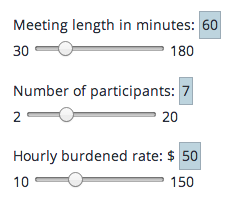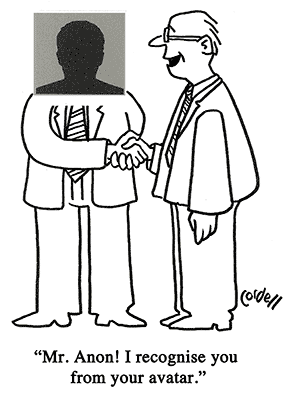Measuring the Cost and Value of Meetings: Part III – Determining Meeting Value
Beauty and Value: both all up in your eyes
A quick preface: value, like beauty, is subjective and personal. Measuring meeting value, then, becomes an exercise of finding a methodology for turning these individual perceptions of value into a consistent and repeatable format.
We propose the following approach:
- Focus your meeting rating on a single question.
Find a single ranking criteria that best expresses the value your organization wants to promote in its meetings, and ask for a ranking after each meeting. One question keeps the feedback collection simple, consistent and fast, improving the odds of actually getting responses. You’ll find more about our recommended question below. - Use a simple, consistent scale.
You want to measure this, right? If so, ask your participants to respond with a meeting value ranking from 1-5 or some other simple scale. We like the old-school grading system of A-F because it holds more emotional impact (drama, even!) for those of us with Western educations. - Encourage comments
After all, you’re only asking a single question, which won’t tell you much about why people ranked the meeting as they did. If you collect feedback, make sure to provide an opportunity for people to elaborate in comments so you can learn specifically what is and is not working in your meetings. - Tie the soft value metric to a hard metric.
This is a bit controversial, but totally powerful. We tie our meeting rankings back to the organizational meeting cost. For example, if we have a meeting that everyone ranks as extremely helpful, we calculate that the meeting actually saved us time and money by making sure that people have clear next steps and no roadblocks. On the other hand, if the meeting drags and doesn’t reach any strong conclusions, we figure we lost not only the time spent in that meeting, but also pay an added penalty for interrupting people’s work.
Our Method: The Lucid Meeting Value Survey
You can assess a meeting on many criteria. Did it start and end on time? Were the presenters engaging? Did the facilitator make sure everyone got a chance to speak and no one dominated the discussion? Did the meeting stay on track? Was there a clear working agreement, and was it followed? How was the temperature in the room? If you want to measurably improve your meeting skills, then you should by all means track these things.
We believe the core function of collaborative meetings is to help a team work together towards a common goal. If you also meet to move work forward rather than to simply practice being good at meetings, then there’s really a single question you need to ask:
Question: Did this meeting get us closer to our goal?
Survey Scale from A to F: a simple grading system
As each team works towards a goal, they take a journey from the conception of the possible to a realization of something tangible – a product, a contract, a policy, a partnership, or perhaps a parting of ways. In keeping with this metaphor, let’s look at the meeting grade in terms of how well each meeting equips each team member for the next stage of that journey.
NOTE: Each participant in your meeting should assign their own grade. Most of the time, people won’t agree. For example, managers often find meetings much more valuable than those responsible for production. That’s ok.
F |
THE MEETING ACTIVELY PREVENTED ME FROM GETTING IMPORTANT WORK DONE, AND HAS MADE IT HARDER TO GET BACK ON TRACK.You’ve left this team member with their car up on cinder blocks in the back yard. Not only is their journey delayed, but they now have to add car repair to their task list. Fail. |
|---|---|
D |
THE MEETING INTERRUPTED MY WORK AND PROVIDED NO NEW HELP.This team member has a functioning car, but no gas. They’ve taken a productivity hit and will need extra time to refuel before they can get back on the road. |
C |
THE MEETING DIDN’T HELP ME WITH MY WORK, BUT IT DIDN’T INTERRUPT ANYTHING IMPORTANT EITHER.This person has a working, gassed up car still sitting in the driveway. Get moving! |
B |
THE MEETING HELPED ME MAKE PROGRESS ON MY WORK.You’ve given this team member the keys and some landmarks to watch for. They’re headed in the right direction and putting miles on the odometer. |
A |
THIS MEETING WAS VERY IMPORTANT FOR MY WORK TO PROCEED.This team member has left the tarmac on a tiger jet. You’ve not only sent them ahead, you’ve given them vital tools to dramatically speed the journey. |
ABOUT THE WORD WORK
For the purpose of assigning a meeting grade, interpret the word “work” as that person’s expected contribution towards the team’s larger goals. The nature of this work will be very different in a product development group than with a volunteer committee, and that’s ok too.
Using Meeting Grades to Improve Meeting Value
The grading system shows you whether the individuals in the meeting felt that it was worth their time – whether they got value out of the meeting. You can also derive an overall grade for each meeting, and watch how this grade trends over time. Benefits to regularly asking this question and tracking the responses include:
- Improved awareness of meeting quality
- To quote noted quality expert W. Edwards Deming, “You can expect what you inspect”. Simply acknowledging that each meeting should make it easier to get work done will focus the number and duration of your meetings.
- Respect for the Flow
- Managers who meet out of habit will get clear feedback on how meetings impact the real work that needs to get done, and time their meetings with a better awareness of their impact on productivity’s flow.
- Better insight into the impact of change
- Tracking a team’s perception of meeting quality over time can highlight improvements in how well a team works together and the impact of any changes the team undergoes. If your team suffers from a change of team members, a project block, or too much awesome weather, you will see this in their meetings.
Even with tracking and awareness, not every working meeting will rank an A. But none should get an F.
 The Calculator: Meeting Grade Applied to Cost
The Calculator: Meeting Grade Applied to Cost
And – another calculator! After your next meeting, poll your participants for a meeting grade. You can then use this meeting value calculator to get a feel for whether you’ve made an effective use of your team’s time.
Caution! Don’t take this one too seriously!
Psychologically, we all evaluate how numbers compare better than we can compare feelings of worth. This tool simply translates a subjective feeling into easily comparable numbers.
Related Posts
You may also be interested in the other posts in this series about measuring the cost and value of meetings:



